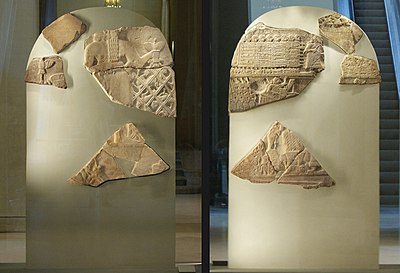
Back Stele van die Aasvoëls Afrikaans የአሞራዎች ጽላት Amharic مسلة النسور Arabic Стэла каршуноў Byelorussian Estela dels voltors Catalan Geierstele German Estela de los buitres Spanish Putreen estela Basque Stèle des vautours French אסטלת הנשרים HE
| Stele of the Vultures | |
|---|---|
 The stele in the Louvre Museum (front and back) | |
| Material | Limestone |
| Size | height: 1.80 metres (5 ft 11 in) width: 1.30 metres (4 ft 3 in) thickness: 0.11 metres (4.3 in) |
| Writing | Sumerian cuneiform |
| Created | Early Dynastic III period (2600–2350 BC) |
| Discovered | Tello, Iraq |
| Present location | Musée du Louvre, Paris |
| Identification | AO 16 IO9, AO 50, AO 2246, AO 2348 |
| Registration | CDLI P222399 |
The Stele of the Vultures is a monument from the Early Dynastic IIIb period (2600–2350 BC) in Mesopotamia celebrating a victory of the city-state of Lagash over its neighbour Umma. It shows various battle and religious scenes and is named after the vultures that can be seen in one of these scenes. The stele was originally carved out of a single slab of limestone, but only seven fragments are known to have survived up to the present day. The fragments were found at Tello (ancient Girsu) in southern Iraq in the late 19th century and are now on display in the Louvre. The stele was erected as a monument to the victory of king Eannatum of Lagash over Ush, king of Umma.[1][2] It is the earliest known war monument.[3]
- ^ Sallaberger, Walther; Schrakamp, Ingo (2015). History & Philology (PDF). Walther Sallaberger & Ingo Schrakamp (eds), Brepols. p. 74–75. ISBN 978-2-503-53494-7.
- ^ The Cities of Babylonia. Cambridge Ancient History. p. 28.
- ^ Bahrani, Z. 2008. Rituals of war: The body and violence in Mesopotamia, New York: Zone Books.
© MMXXIII Rich X Search. We shall prevail. All rights reserved. Rich X Search